Owls, elusive yet beautiful, are a treat to spot in the wild. The fact that most of us never see them due to their camouflage and nocturnal habits makes them all the more mysterious. It can also lead you to wonder which species of owls can be found in your home state. In this article we will look at owls in Wyoming and learn a bit about their size and appearance, as well as what part of the state they can be found in.
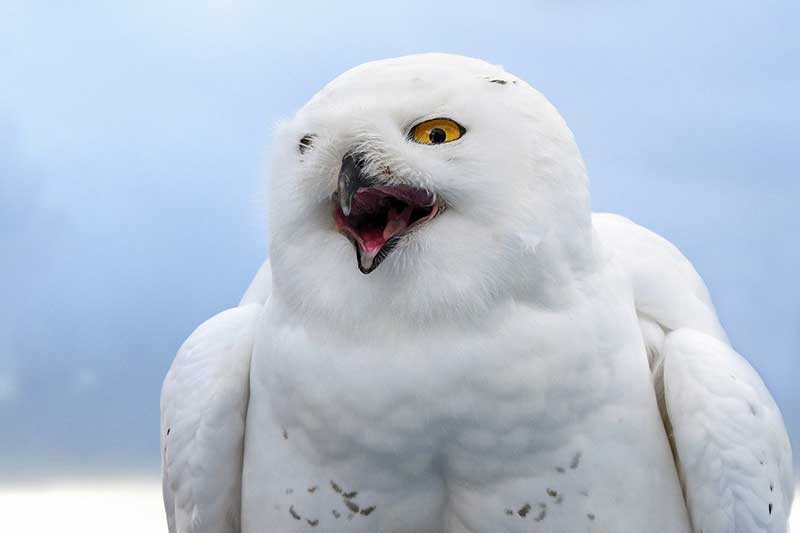
It is currently thought that there are about 19-20 species of owls found in North America. The state of Wyoming is home to at least 13 of these owl species!
Let’s take a look at those species and learn a bit about them, shall we?
The 13 species of owls in Wyoming
The 13 species of Owls found in Wyoming are Northern Saw-whet Owl, Barn Owl, Great Horned Owl, Long-eared Owl, Short-eared Owl, Flammulated Owl, Western Screech Owl, Eastern Screech-owl, Snowy Owl, Northern Pygmy Owl, Burrowing Owl, Great Gray Owl, and the Boreal Owl.
While you can always get sightings of uncommon owls passing through or spending time over the border from a neighboring state, our research from allaboutbirds.org and Audubon shows the following 13 owl species are currently found in Wyoming at various times of the year and different parts of the state.
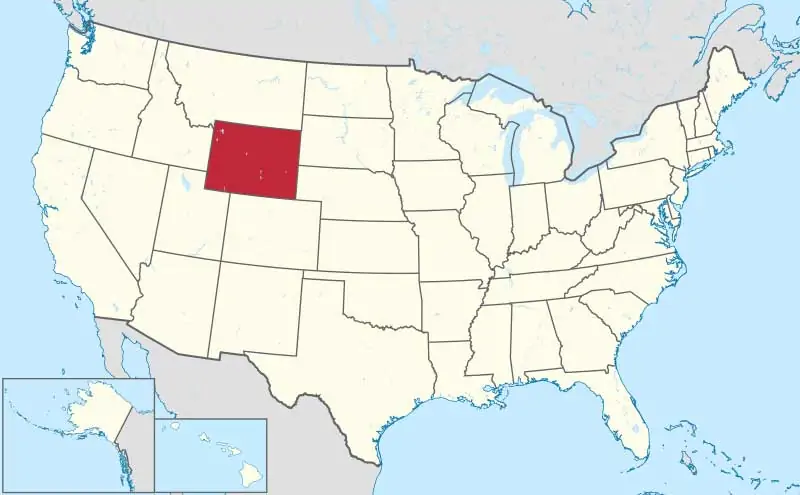
1. Northern Saw-whet Owl
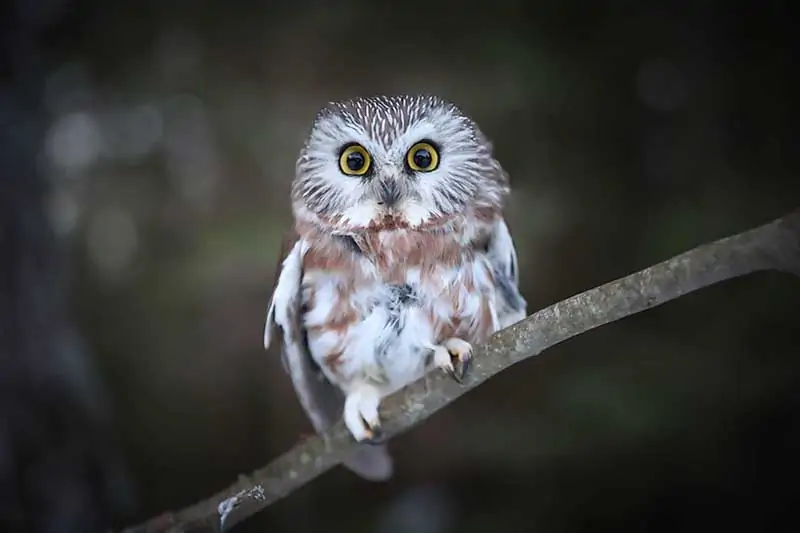
- Length: 7.1-8.3 inches
- Weight: 2.3-5.3 oz
- Wingspan: 16.5-18.9 inches
The best bet for catching a glimpse of a Northern Saw-whet Owl is to learn it’s call and listen for it at night. Luckily, they have a distinct call that sounds like a blade being sharpened with a whetstone, earning the name “saw-whet” owl. During late winter through early summer they tend to call more frequently, so be sure to listen to a high-pitched, “too-too-too” call around then.
The female Northern Saw-whet Owl keeps a very tidy nest. She leaves her chicks after they are about 18 days old and the male continues to feed them until they leave the nest about 10 days later. In typical youthful fashion, the young owls do not clean up after themselves, and by the time they leave home the nest is coated in rotting prey, pellets, and fecal matter.
As one of the smallest owls in Wyoming, these little guys are notoriously difficult to locate. Northern Saw-whet Owls can be found in western parts of Wyoming year-round, but in the eastern portions of the state they are mostly non-breeding residents.
Their mottled brown plumage blends in easily to the trees around them, especially when they’re perched motionlessly on a branch. These owls are also naturally secretive, preferring to lay low and avoid being noticed. Like most other owls, they’re also only active at night.
2. Barn Owl
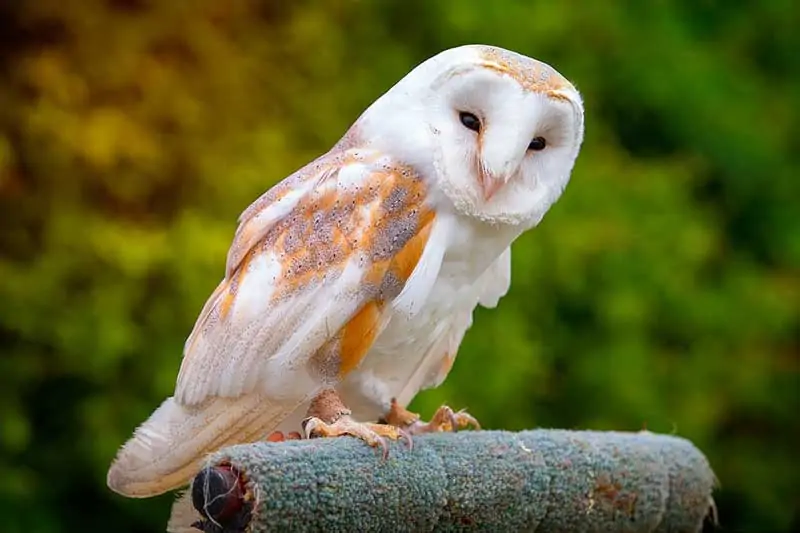
- Scientific name: Strix alba
- Length: 12.6-15.8 inches
- Weight: 14.1-24.7 Oz
- Wingspan: 39.4-49.2 inches
The Barn Owl, with its distinctive screech, is a permanent resident of Wyoming and found throughout most of the entire state. This owl lives up to its name and can often be found occupying barns, and other abandoned structures. They also roost in hollow tree trunks and thick clumps of trees.
These nocturnal predators hunt open fields at night, looking for rodents, which they will swallow whole. This habit of swallowing prey in one gulp means that rather than passing from one end to the other, the owl forms “pellets” which it coughs up. These pellets give an excellent peek into the owl’s diet and are used by researchers to learn more about the owls and their feeding habits, as well as by students.
There are at least 46 varieties of Barn Owl worldwide. The North American version is the largest, while the smallest comes from the Galapagos Islands. The North American Barn Owl is twice the size of its diminutive island cousin. Despite their global presence, habitat loss is beginning to affect their populations in some areas.
3. Great Horned Owl

- Scientific name: Bubo virginianus
- Length: 18.1-24.8 in
- Weight: 32.1-88.2 oz
- Wingspan: 39.8-57.1 in
An image of the Great Horned Owl probably comes to mind when you think of owls, with its large booming hoot and long, horn-like tufts where it gets its name from. It’s one of the most common owls in North America and can be found in nearly any semi-open areas between the Arctic and the tropics.
This owl is a very adept predator that can take down birds and mammals much larger than itself, even including other raptors like ospreys. When larger prey isn’t available, it will also consume tiny scorpions, mice, and frogs.
The Great Horned Owl is well adapted to all weather, as it has extremely soft feathers that insulate against the cold and also serve to muffle the sounds of their flight when in pursuit. This amazing bird has a grip strength that can easily sever the spine of large prey, and requires a force of 28 pounds to open back up. The owl uses this vice-like grip to sever the spines of it’s larger prey.
If you ever hear a group of American crows get agitated, they may be mobbing a Great Horned Owl, which is their most dangerous predator. They may continue harassing the owl for hours until it finally leaves.
One of the largest owls in Wyoming, this bird of prey is a permanent resident in all of Wyoming as well as the rest of United States with only the exception of Hawaii.
4. Long-eared Owl

- Scientific name: Asio otus
- Length: 13.8-15.8 inches
- Weight: 7.8-15.3 oz
- Wingspan: 35.4-39.4 inches
The Long-Eared Owl is the most comfortable roosting in dense foliage. The Long-eared Owl has a year-round presence in the state of Wyoming. They can be difficult to spot, but they are in the state and can be found if you know when to look, where to look, and just as important.. what to listen for. Though they enjoy the woods for roosting, they need wide-open areas for hunting.
The ear tufts on its head that give the Long-Eared owl its name are not its only distinguishing feature. The male owl has a call that can be heard 1 kilometer (just over half a mile) away. The Long-Eared Owl has a variety of calls, it has a typical “hoot” and also makes a barking sound.
The Long-Eared Owl is an efficient hunter, with hearing so precise it can snatch insects in pitch darkness. They are extremely elusive animals but can be spotted by looking for their pellets on the ground. All owls have distinctly shaped pellets. In the winter, when they roost in groups, they may also be easier to spot.
5. Short-eared Owl
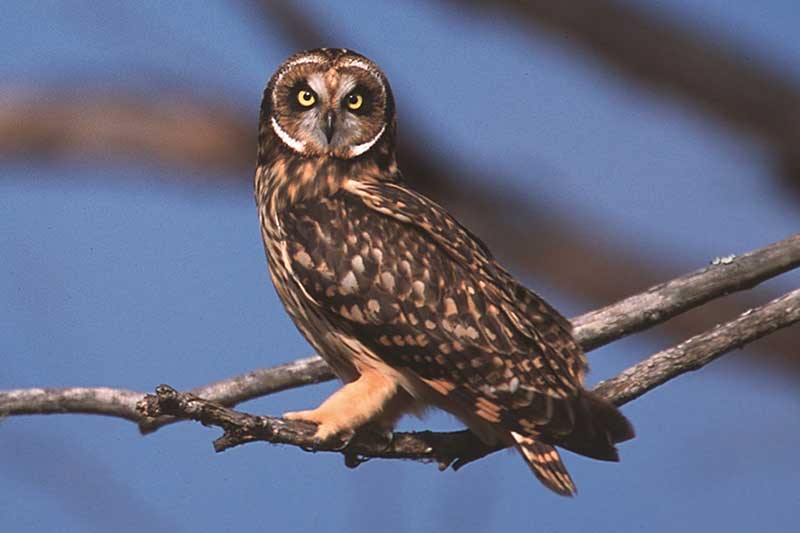
- Scientific name: Asio flammeus
- Length: 13.4-16.9 in
- Weight: 7.3-16.8 oz
- Wingspan: 33.5-40.5 in
Short-eared Owls prefer open fields and grasslands, and have adapted well to humans by moving into airports as well, as the planes coming in for a landing displace insects for the owl to swoop up and catch. They get their name from their ear tufts, similar to the Great Horned Owl, though they are so short on this species that they’re often invisible.
Short-eared Owls soar silently over grasslands on broad, rounded wings and are most active around dawn and dusk. They use their incredibly acute hearing to track and hunt small mammals and other birds. It’s also one of the few species that has appeared to benefit from strip-mining, as it’s been found often nesting on reclaimed and replanted mines.
This open-country hunter is one of the world’s most widely distributed owls, and among the most frequently seen during the daytime. Short-eared Owls are capable of traveling long distances, as shown by their distribution, and there have even been reports of these owls descending on ships hundreds of miles from land.
Short-eared Owls are found throughout the entire state of Wyoming all year long.
6. Flammulated Owl

- Scientific name: Psiloscops flammeolus
- Length: 5.9-6.7 in
- Weight: 1.5-2.2 oz
- Wingspan: 15.9-16.1 in
The Flammulated Owl is a very small, reddish owl found in a tiny pocket in Southern Wyoming, during the breeding season in the summer only. From what I can gather, they most likely have a small breeding population in Medicine Bow-Routt National Forest.
It’s scarcely larger than a small juice can, making it an extremely difficult animal to spot and considered a notable find for bird watchers. It spends the majority of its time foraging for insects near the tops of massive pine and fir trees.
This owl is highly migratory, wintering in Mexico and Central America, but because of its size and migratory habits, little else is known about its activities when there. They’re also so well camouflaged that finding one during the daytime is worse than finding a needle in a haystack.
An interesting fact about this owl is that it’s able to make a deep, low-pitched hoot that makes it sound like a much larger owl, thanks to its unusually large windpipe!
7. Western Screech-owl
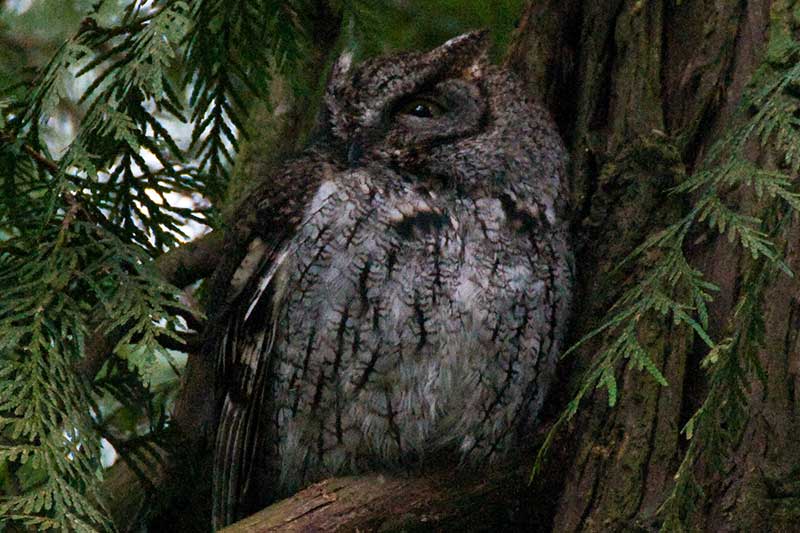
- Scientific name: Megascops kennicottii
- Length: 7.5-9.8 in
- Weight: 3.5-10.8 oz
- Wingspan: 21.6-24.4 in
The Western Screech-owl hunts in woods and deserts of western North America. Pretty uncommon in the state, they are found in just a few select areas of far Western and Northern Wyoming. They have an extremely wide range in diet, which includes everything from worms and crayfish to rats and bats.
They’ve adapted well to human presence, and can often be found in urban parks and residential areas as well as the wilder places. They’ll often nest in backyard boxes, making them beloved by locals.
Despite its name, it doesn’t really “screech”; instead it’s more likely an accelerating series of hollow toots. Despite its smaller size, it’s a powerful predator that’s capable of taking down prey much larger than its own body, including cottontail rabbits.
This is the type of owl most seen camouflaged against a tree opening, as they are capable of pressing their head and body feathers against the tree to properly blend in.
8. Eastern Screech-owl

- Scientific name: Megascops asio
- Length: 6.3-9.8 inches
- Weight: 4.3-8.6 oz
- Wingspan: 18.9-24.0 inches
The Eastern Screech Owl is a common owl found in most wooded areas within its range. Eastern Screech-owls are year-round residents to Wyoming, but only in a few small areas to the far north and southeastern areas of the state. Within its range, they can be found in any area that has a large concentration of trees. The Eastern Screech Owl’s mottled brown and grey feathers, allow it to blend very well into the trees, making it a master of disguise.
The Eastern Screech Owl is an expert at hiding, but it produces pellets which it expels at the base of the tree where it lives. Not only does this provide a good opportunity to investigate the owl’s diet, but it also gives clues as to where you can find an Eastern Screech Owl.
Although Eastern Screech Owl typically mates for life, occasionally the male will mate with two females. When this happens the second female will kick the first one out of her nest. She will then lay her own eggs, and incubate both sets of eggs.
9. Snowy Owl
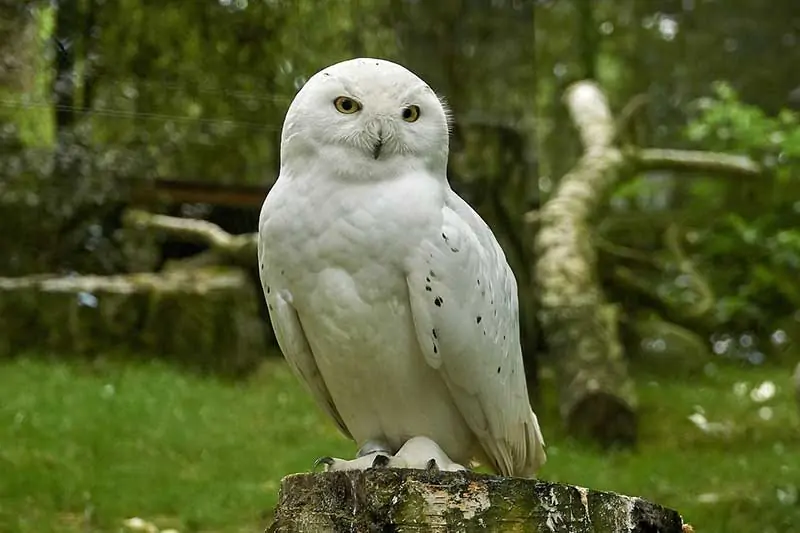
- Scientific name: Bubo scandiacus
- Length: 20.5-27.9 inches
- Weight: 56.4-104.1 oz
- Wingspan: 49.6-57.1 inches
Snowy Owls are not a common sight in the United States. Their habitat is generally much further north. Though Snowy Owls will occasionally appear and stay for the Winter in some U.S. states.
Wyoming is within the Snowy Owls irruptive winter range and is one state where Snowy Owls make an occasional appearance. An irruptive range is an irregular range and means they will appear some winters and not others. Snowy Owls that have established a site they winter at, will continue to use that same site.
If there are Snowy Owls near you, they are not as difficult to spot as other owls. They roost in obvious places, and unlike most other owls, they are diurnal and thus active during the day. Snowy Owls prefer wide-open spaces for hunting, but they will perch on a high point.
Unlike other owl species, Snowy Owls are not afraid to leave their place of birth. Owls from the same nest, that were tracked, were found hundreds of miles away from each other, in opposite directions.
10. Northern Pygmy Owl
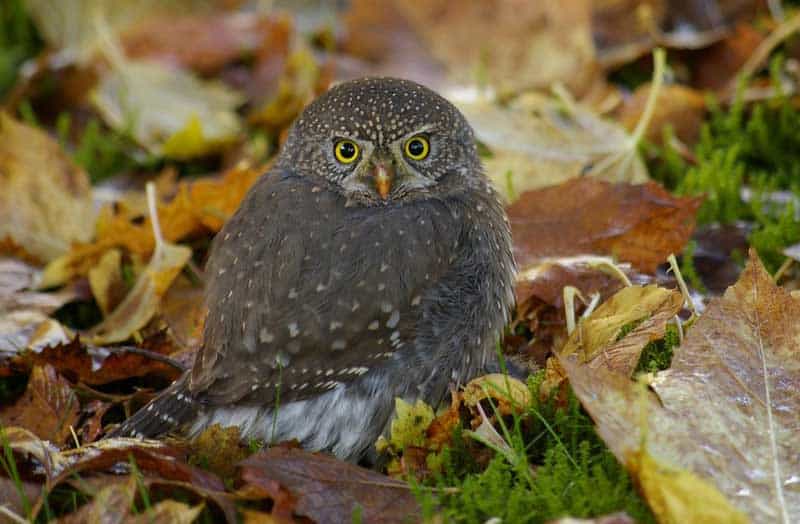
- Scientific name: Glaucidium gnoma
- Length: 6.3-7.1 in (16-18 cm)
- Weight: 2.1-2.5 oz (60-70 g)
- Wingspan: 14.5 – 16 in.
These tiny owls are only seen in the more mountainous areas of Northwestern Wyoming, preferring forested places with some open space. Often active during the daytime, they lie in wait to ambush smaller birds.
Perhaps because they are daytime hunters, Northern Pygmy Owls lack the asymmetrical ear placement that is common in other owls to give them advanced hearing skills. These owls also have dark spots on the back of their heads to look like eyes. These “eye looking spots” are thought to be there to scare off chickadees and other small birds that will team up and mob the owl.
As mentioned, Northern Pygmy Owls are generally widespread in the mountainous western United States and are found year-round in these parts of Wyoming. Because they’re more active in the day, they are a little easier to spot than nocturnal owls. However they’re also pretty small and tend to perch still waiting for prey – so you still need to keep your eyes peeled to catch a glimpse.
11. Burrowing Owl
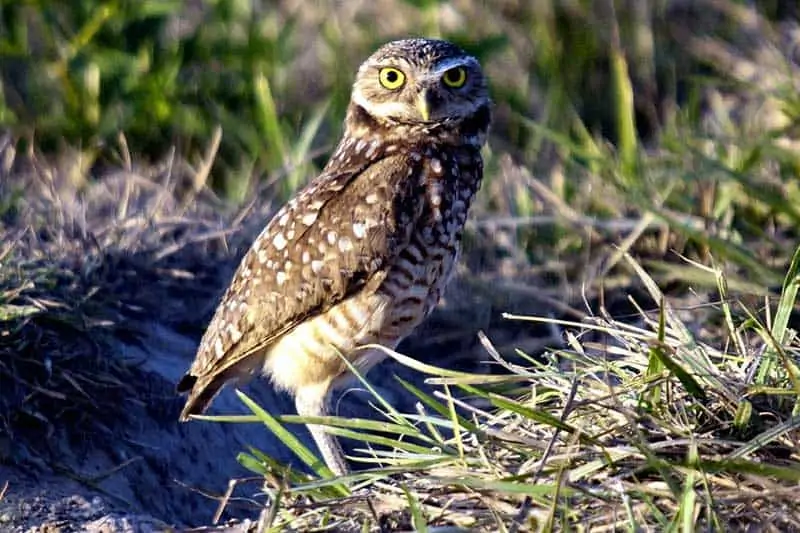
- Scientific name: Athene cunicularia
- Length: 7.5-9.8 in (19-25 cm)
- Weight: 5.3 oz (150 g)
- Wingspan: 21.6 in (55 cm)
Burrowing Owls are residents throughout Wyoming during their breeding season, but then travel south for warmer climes during the winter. Unlike all other owls, Burrowing Owls live and nest in underground burrows, usually ones abandoned by prairie dogs or other animals. Their habitat is primarily wide stretches of grassland and prairie.
Because of where they like to live, these owls are becoming more rare because their burrows are increasingly hard to come by. They have an extremely varied diet, eating everything from small mammals to grasshoppers or scorpions.
Burrowing Owls have smooth, round heads with no ear tufts, and sandy-colored plumage with brown spots. These owls don’t rely on flying to catch prey, either. Instead, they hunt on the ground, chasing after insects and small animals with their long legs that have helped them adapt to life on the ground. These smart owls will also store extra food away in these underground chambers to sustain them through incubation and brooding periods.
12. Great Gray Owl
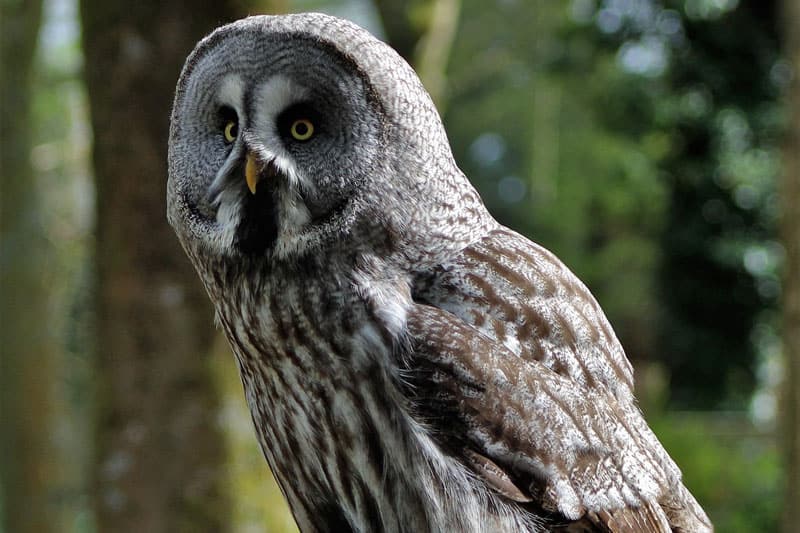
- Scientific name: Strix nebulosa
- Length: 24.0-33.1 in
- Weight: 24.7-60.0 oz
- Wingspan: 53.9-60.2 in
Great Gray Owls are only found in Western or Northwestern Wyoming, near the border to Idaho or Montana. Even in these areas they are fairly rare and mostly part-time residents. They’re very large owls with broad wings and long tails, one of the tallest owls in America in fact. Their eyes appear small and close together on their big facial disks, giving them a unique expression. A white “X” pattern on their faces is another key identifier. Like their name implies, their bodies are covered in fluffy, silvery gray feathers.
Great Gray Owls tend to be elusive and difficult to spot, and not really the type to bring attention to themselves. They reside in dense pine forests and on the edges of meadows, avoiding areas with people. Like most owls, they are most active at night when they hunt – most often in the hours before dusk and dawn. They often make their homes in dead trees and may be perched at any level.
Even though Great Gray Owls are the tallest owls in Wyoming and the United States, they are not the heaviest. Despite their lack of weight they have been seen breaking through snow that was strong enough to support a human to catch a small animal. Their size requires that they eat at least 7 animals of around vole size a day.
13. Boreal Owl
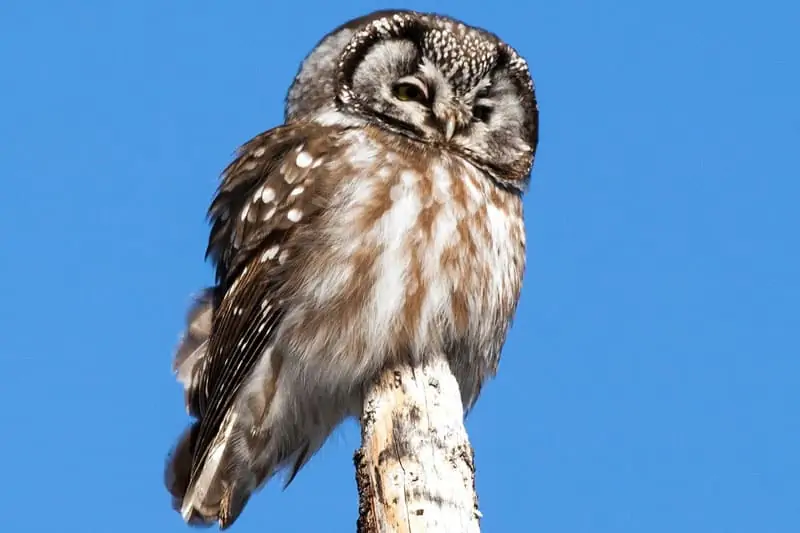
- Scientific name: Aegolius funereus
- Length: 8.3-11.0 in
- Weight: 3.3-7.6 oz
- Wingspan: 21.6-24.4 in
Boreal Owls are found year-round in the areas of Central and Southeastern Wyoming in dense mixed-wood and coniferous forests. They’re mysterious birds and are often hard to spot, especially during the day. They roost in a different tree everyday, so don’t expect to find them in the same spots.
At about the size of a robin, they’re small owls that lack ear tufts but have large, square heads with stocky bodies and short tails. At night they perch and wait for prey such as small mammals and birds before swooping down and grasping their meal with their talons.
Boreal owls are usually quiet and don’t call very frequently. However, in the late winter through the spring this behavior changes as males call more often for mates. Listen for these quick hoots at night for a better chance at finding them.





